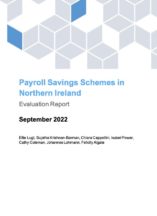As part of the UK Strategy for Financial Wellbeing, the Money and Pensions Service (MaPS) aim to encourage two million more working-age people on low-to-modest incomes into the habit of saving regularly by 2030. One way to support people struggling to save is through payroll saving schemes. BIT partnered with MaPS to evaluate the roll-out of payroll savings schemes in two small and medium businesses in Northern Ireland.
What is a payroll savings scheme?
Research shows that 10 million working-age people in the UK do not save regularly – two million people having no any savings at all – and current cost-of-living pressures are likely to impact this further.
Payroll savings is making regular savings directly from an employee’s pay. An employer deducts the amount the employee wishes to save directly from wages, via the payroll, into a savings account.
Payroll savings schemes aim to help people build a savings buffer or support goals-based saving by diverting a proportion of pay into a savings vehicle each month. Like pension savings, the automated ‘set and forget’ nature of this process makes it easy for people to save by making it habitual and effortless.
How we ran this study
We reviewed how the payroll savings scheme was set up by employers and credit unions, how the scheme was communicated to employees, and how users signed up to the payroll savings schemes.
Using a mixed-methods approach, comprising of semi-structured interviews and survey data, we evaluated facilitators and barriers to take-up.
Key findings
- People found both the ‘set and forget’ nature of payroll savings and the flexibility to withdraw or modify their contributions appealing. This suggests that schemes should continue to highlight both aspects in their communications.
- Trust and word-of-mouth are important facilitators in boosting take-up of payroll savings.
- For people who weren’t already saving, the biggest barrier to take up was concern about whether they would be able to afford to save every month. These individuals felt embarrassed about having to potentially communicate this to their employers.
- Take-up of payroll savings at both companies was around 5–10%. This is relatively high compared with evidence of take-up rates in other schemes in the UK.
- Users and non-users alike felt that take-up would be higher if an incentive were offered, which supports findings from other studies.



